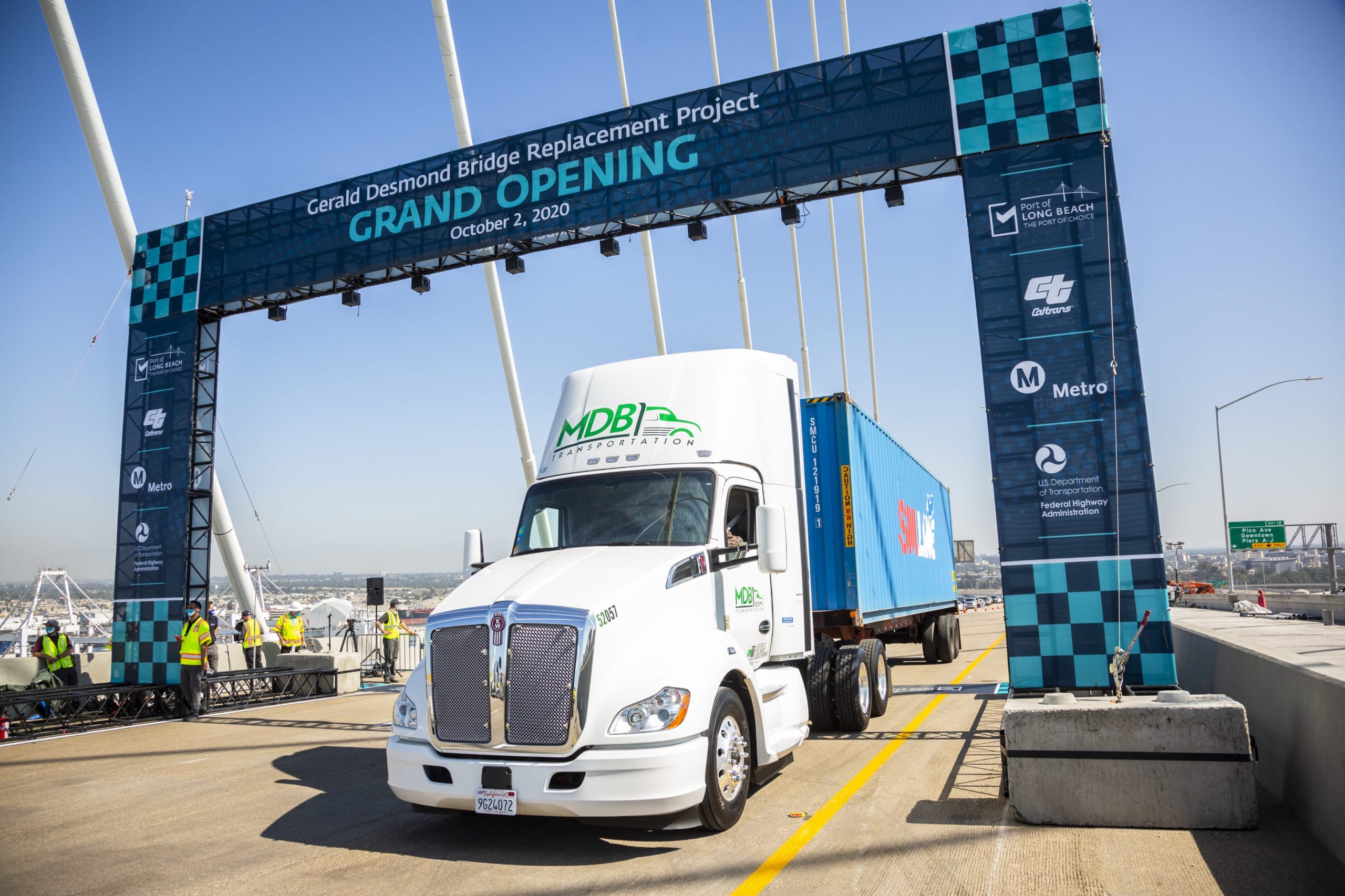On Friday October 2nd, several Southern California trucking companies proudly showcased their near-zero-emission (NZE) natural gas trucks in a clean truck parade to commemorate the opening of the new Port of Long Beach bridge. The seven fleet operators—NFI, Total Transportation Solutions, Inc. (TTSI), MDB Transportation, Tradelink Transport, Pacific 9 Transportation, Overseas Freight, and Green Trucking—collectively operate 157 natural gas heavy-duty trucks that log more than 6.4 million miles per year, hauling freight daily to and from the ports of Long Beach and Los Angeles. In total, more than 700 natural gas trucks regularly haul freight to and from the two ports, representing approximately 6 percent of the active drayage truck fleet.
In total, more than 700 natural gas trucks regularly haul freight to and from the two ports, representing approximately 6 percent of the active drayage truck fleet.
The newly opened Port of Long Beach bridge will serve as a vital part of the country’s trade infrastructure, with 15 percent of the nation’s imported waterborne cargo trucked over it. The $1.47 billion bridge project was a joint effort of Caltrans and the Port of Long Beach, with additional funding support from the U.S. Department of Transportation and the Los Angeles County Metropolitan Transportation Authority (Metro). The commemorative clean truck parade was organized by the Port of Long Beach and the Harbor Trucking Association, a coalition of intermodal carriers serving America’s West Coast Ports.
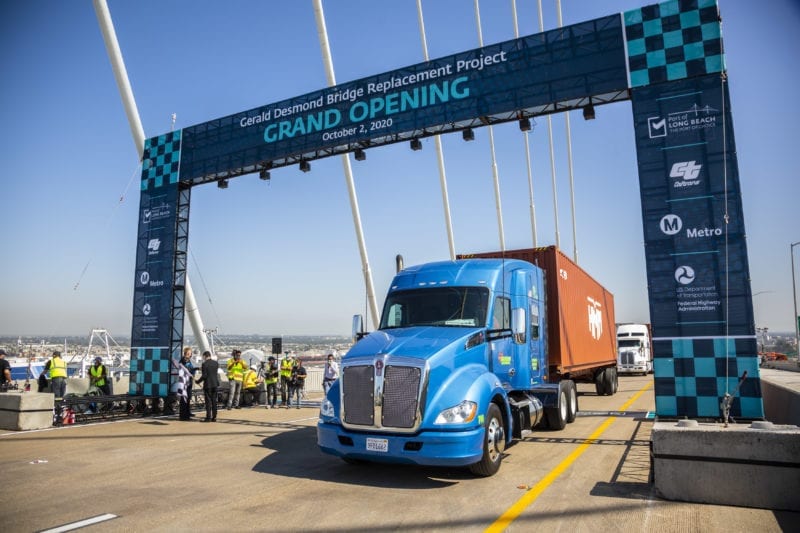
Overseas Freight participated in Port of Long Beach Clean Truck parade with an LNG-fueled Kenworth P680.
“The clean truck parade demonstrates our members’ commitment to reducing their carbon footprint by investing in sustainable transportation technologies and fuels,” noted Weston LaBar, Chief Executive Officer of the Harbor Trucking Association. “The near-zero emission natural gas trucks on display today have already made a measurable impact on emissions from the drayage truck fleet serving the ports of Los Angeles and Long Beach and have played a large role in the success of the ports’ Clean Trucks Program.”
In May 2020, the ports of Long Beach and Los Angeles upgraded near-zero-emission (NZE) heavy-duty natural gas trucks to the highest Technology Readiness Level—TRL 9
In May 2020, the ports of Long Beach and Los Angeles upgraded near-zero-emission (NZE) heavy-duty natural gas trucks to the highest Technology Readiness Level—TRL 9— in the Feasibility Assessment for Drayage Trucks. NZE natural gas trucks are the first technology in the Ports’ assessment to achieve the TRL 9 rating.
The fleets in the parade operate natural gas trucks that were factory built by Freightliner, Kenworth, Mack, Peterbilt and Volvo, and are commercially available for purchase across the nation. The heavy-duty, class 8 trucks feature Cummins Westport’s NZE ISX12N near-zero emission (.02 g NOx / bhp-hr) natural gas engine, which is 90 percent cleaner than the EPA’s current heavy-duty NOx emission standard. The near-zero ISX12N engine even powers several heavy-duty trucks that operate in the ports’ overweight corridor with a gross vehicle weight rating (GVWR) of up to 96,000 pounds, providing comparable operating capabilities as its diesel counterparts.
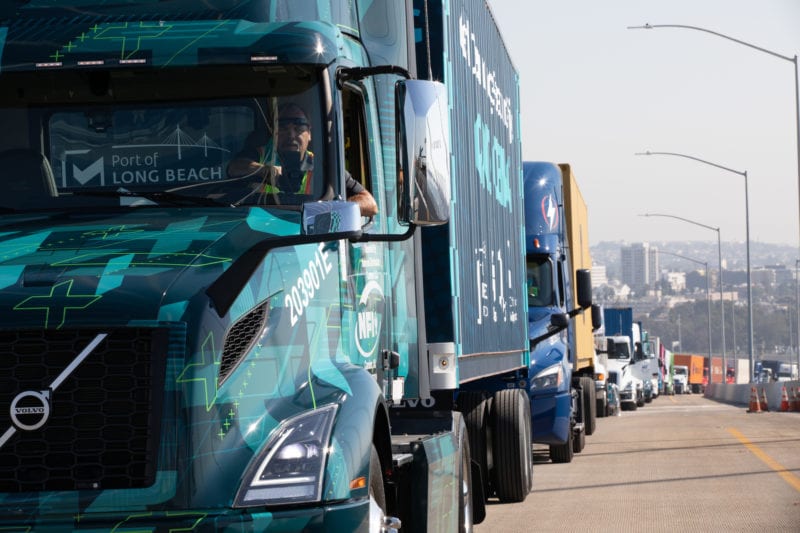
Image: Volvo Trucks
The fleets represented in the parade operate low- and zero-emission trucks from Volvo, Freightliner, Kenworth, Mack, Peterbilt, BYD, and others.
“MDB Transportation has had great success with the 30 near-zero emission natural gas trucks in our fleet and plans to deploy another 40 trucks by mid-2021,” said Jack Khudikyan, Principal Owner from MDB Transportation. “The 12-liter natural gas trucks have been a seamless replacement for our diesel trucks given their 600-mile range, and the great power and speed they offer when hauling a full container.”
“The current generation 12-liter natural gas trucks are absolutely built for prime time, which is why we plan to add another 20 to our fleet by mid-2021,” said Vic LaRosa, CEO and President of TTSI. “TTSI has been hauling freight with natural gas trucks since 2008, having added more than 100 CNG and LNG trucks to our fleet over the past 12 years. With both battery-electric and fuel cell trucks also running in our fleet, I can tell you that today’s natural gas trucks are a decade beyond the early pilot and demonstration stage of zero emission technologies.”
Each day, more than 17,000 drayage trucks haul freight to and from the Ports of Los Angeles and Long Beach—nearly 40 percent of the nation’s total containerized import traffic and 25 percent of its total exports combined. Heavy-duty diesel trucks are one of the largest sources of emissions in Southern California, contributing to the region’s consistently poor air quality—the worst in the nation.
Heavy-duty diesel trucks are one of the largest sources of emissions in Southern California, contributing to the region’s consistently poor air quality.
Several of the fleets that participated in the parade have received incentive funds from the South Coast Air Quality Management District (AQMD) or other programs in California to accelerate their fleet turnover. Southern California only has until the end of 2022 to significantly cut ozone-forming NOx emissions in order to reach minimum standards set by the federal government for clean and healthy air, known as National Ambient Air Quality Standards, or NAAQs. Failure to meet these federal air quality standards can trigger fines and penalties, including withholding billions of dollars of federal highway funds.
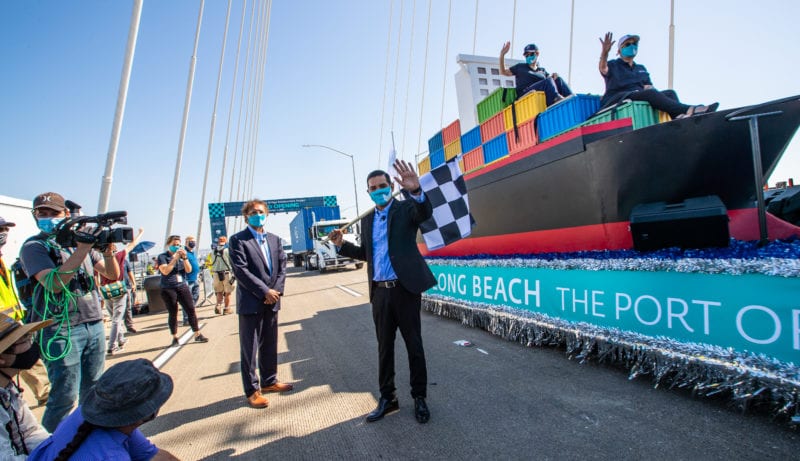
Long Beach Mayor Robert Garcia provided opening remarks to commemorate the bridge opening.
Southern California has until the end of 2022 to significantly cut ozone-forming NOx emissions in order to reach minimum National Ambient Air Quality Standards, or NAAQs.
“I commend the fleets participating in today’s clean truck parade for being at the forefront of reducing emissions. Cleaning up our heavy-duty fleets is critical to improve our air quality across the entire region, particularly in disadvantaged communities,” said Wayne Nastri, executive officer at South Coast AQMD.
Clean Energy provides the drayage fleets represented in the clean truck parade with 100% renewable natural gas (RNG), a low-carbon fuel produced from organic waste, enabling each organization to further lower its carbon footprint. Southern California drayage fleets have access to an extensive public natural gas refueling network from Clean Energy, Trillium, SoCalGas and other fuel providers, including multiple high-volume truck capable stations in the San Pedro Bay Ports, Southeast Los Angeles, and Inland Empire region.
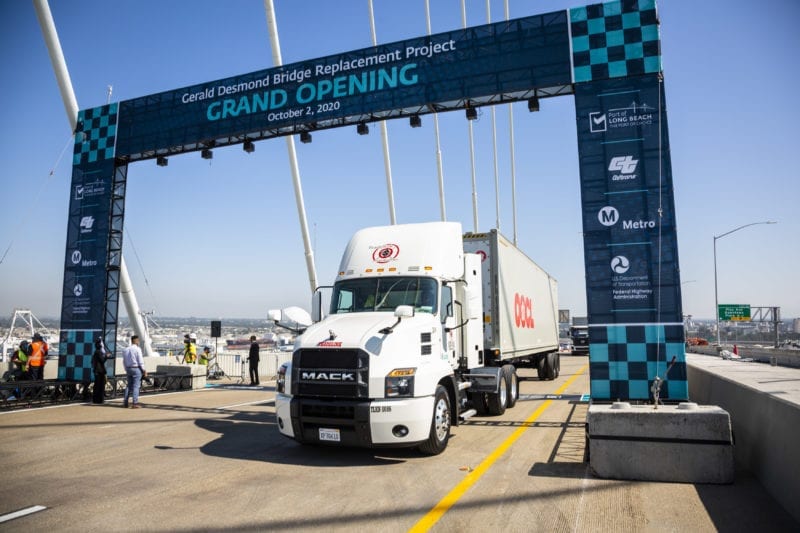
Tradelink Transport operates 21 CNG Mack Anthem trucks in its Southern California drayage fleet.
In July, Clean Energy announced a partnership with Chevron called “Adopt-a-Port” that will allow truck operators serving the ports of Los Angeles and Long Beach to subsidize the cost of buying new near-zero natural gas trucks. Truck operators participating in the program will fuel with renewable natural gas (RNG), reducing smog-forming NOx emissions by 98% while also reducing greenhouse gas emissions compared to diesel trucks.
Truck operators participating in the program will fuel with RNG, reducing smog-forming NOx emissions by 98% while also reducing greenhouse gas emissions compared to diesel trucks.
“As part of our environmental and sustainability goals, Pacific 9 has fueled its fleet of 27 near-zero natural gas trucks with renewable natural gas since early 2018, enabling us to drive a million a miles per year with wheel-to-wheel emissions that are equivalent to a battery-electric truck,” said Alan Ta, chief operating officer at Pacific 9 Transportation. “No other commercially available technology enables us to achieve these significant emission reductions while continuing to meet the demands of our daily operations. We have plans to add another 10 to 15 near-zero natural gas trucks to our fleet by the end of 2021. This effort has greatly contributed to our customers’ environmental goals, as well.”
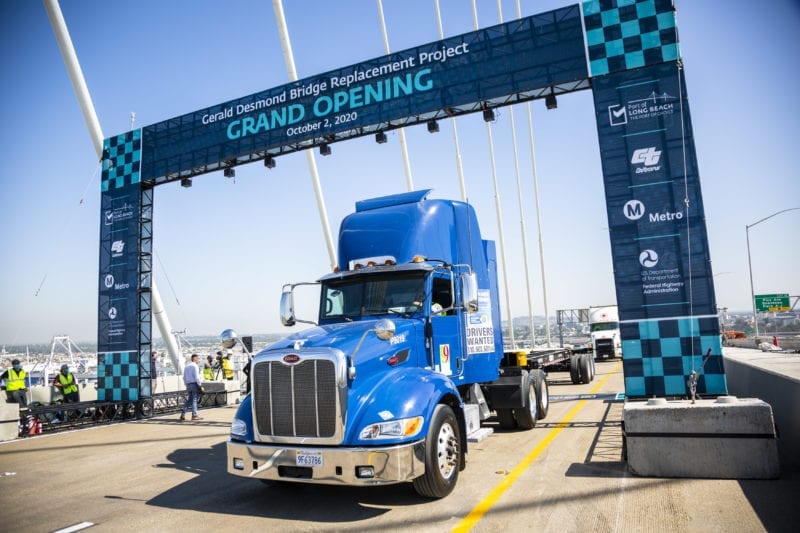
Pacific 9’s fleet of natural gas trucks enables the company to achieve its economic and environmental sustainability goals.
“No other commercially available technology enables us to achieve these significant emission reductions while continuing to meet the demands of our daily operations.”
To learn more about how NZE natural gas trucks fueled by renewable natural gas offer one of the best options to help California achieve clean air and climate change mitigation as quickly, effectively, and efficiently as possible, visit www.cngvp.org.
About CNGVP
The California Natural Gas Vehicle Partnership (CNGVP) is an alliance of air quality, transportation and energy agencies, vehicle and engine manufacturers, fuel providers, transit and refuse hauler associations, and other stakeholders interested in increasing and strengthening the deployment of near-zero emission (NZE) natural gas vehicles throughout California. www.cngvp.org

